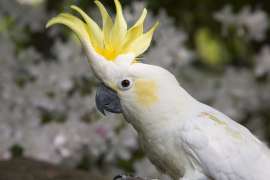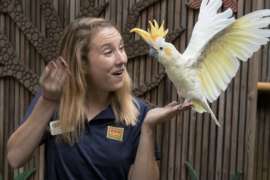Yellow-crested Cockatoo
Yellow-crested Cockatoo
With only between 1,000 and 2,500 yellow-crested cockatoos remaining in the wild, these birds are critically endangered. Like other animals found on Indo-Pacific islands, habitat loss and fragmentation are major threats to their survival.
Cacatua sulphurea
Herbivore
Southeastern Asia [VIEW MAP]
Rainforests, Scrublands
Look for Sydney, the yellow-crested cockatoo, in a bird presentation at the World of Wild Theater with her other feathered friends. Check your map for presentation times!
Photos and Videos
Look for Sydney, the yellow-crested cockatoo, in a bird presentation at the World of Wild Theater with her other feathered friends. Check your map for presentation times!
Yellow-crested cockatoos are named for the beautiful yellow crests on top of their heads. This smaller parrot weighs around ½ pound. They are mostly white and have patches of yellow underneath their wings. It is thought that both the underwing coloration and brightly colored crests are means of communication with flock mates. Like other members of the Psittacine order, these parrots have zygodactyl feet which allow them to easily move through tree branches to reach nearby fruits and flowers. Their short tails allow for moving around dense forests.
These parrots live in small flocks or pairs, but larger flocks may be seen when food is abundant. Breeding typically occurs in September to May on the island of Sumba. Birds nest in cavities in tree hollows of dead or rotting trees or use a tree hollow created by another animal.
Look for Sydney, the yellow-crested cockatoo, in a bird presentation at the World of Wild Theater with her other feathered friends. Check your map for presentation times!
Yellow-crested cockatoos are found on the islands of Indonesia. They have also been introduced in Singapore.
It was once thought that these birds required primary forest, but on the island of Sulawesi they live in more open scrubland. They can be found in both moist and dry forests.
Favored wild items include fruits of Artocarpus communis, fruit and flowers of the coconut palm, young leaves and flowers of some species of mangroves, and the male flowers of Brassus sudaica. At the Zoo, Sydney enjoys a diet of commercially-prepared bird pellets, seeds, nuts, fruits and vegetables.
Increasing the population of yellow-crested cockatoos has become a priority for the national Indonesian Ministry of Forestry and Environment. As of 2005, the species is listed under appendix I of CITES (the Convention on International Trade in Endangered Species of Wild Fauna and Flora). The trade of yellow-crested cockatoos is subject to strict regulation and is only authorized in exceptional circumstances. An updated recovery plan has been in place since 2012. Active initiatives include putting plastic rings around trees with nests to deter predation and local education efforts to discouraging capturing for the illegal pet trade. Habitat restoration has helped to increase nesting sites and sunflower fields have helped to draw them away from other crops to reduce retaliatory hunting.



